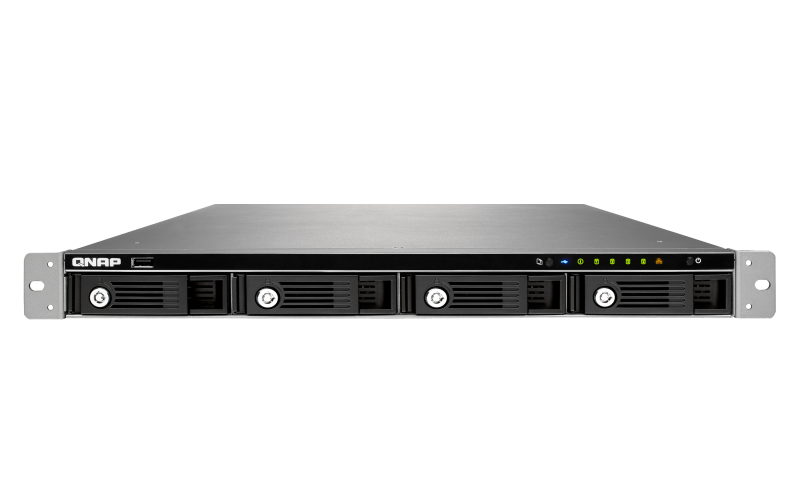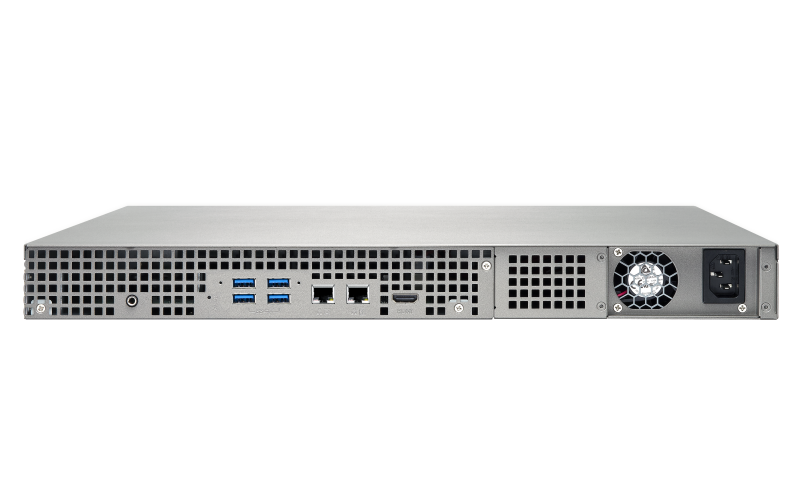 The QNAP TS-451U is the entry-level rack mounted NAS for SoHos and small businesses. Does this low(er) cost, 4-bay 1RU rackmount unit have what it takes to do the job? With thanks to QNAP, DigitalReviews gets to check out this unit.
The QNAP TS-451U is the entry-level rack mounted NAS for SoHos and small businesses. Does this low(er) cost, 4-bay 1RU rackmount unit have what it takes to do the job? With thanks to QNAP, DigitalReviews gets to check out this unit.
“In the entry-level rack-mountable NAS segment, we are glad to be the first NAS company to introduce the energy-efficient, 64-bit Celeron®-powered TS-451U, which is designed for budget-conscious SOHO users to store and back up data without sacrificing performance,” said Jason Hsu, product manager of QNAP. “Coupled with feature-rich business applications, QvPC Technology, Virtualization Station and 1080p video transcoding, the TS-451U delivers the best cost-effectiveness for growing business data needs.”
First Impressions
Being no stranger to QNAP devices, this unit lives up to its predecessors pedigree. A decent unit overall, the chassis and drive carriers are both made from metal and solidly built. Rackmount kits do not seem to differ hugely between models and brands, the TS-451U is no different with a front fascia dominated by the 4 drive bays. Above that is an USB 2.0 port and a slim row of LED lights shows system status, network activity and installed drives and activity.
Around the back is a single power supply, 4 USB 3.0 ports, dual Gigabit port, a HDMI output and a console port.
Under the hood of this pizza box is a Dual-core Intel® Celeron® 2.41GHz CPU and 1GB DDR3L SDRAM out of the factory. Six screws later the lid is off and the TS-451U can be upgraded to a maximum of 8GB of RAM with the two SODIMM slots.
In Action
The four hot-swap drive bays are certified to support up to 8TB drives from Seagate and HGST. That’s a pretty decent amount of storage in one chassis (or a lot of eggs in one basket)!
With the unique Cloud-Key code on the unit’s lid, the QNAP cloud portal makes it easy to find and configure the device. Me being the control freak IT geek I decided to go the manual way via IP address. Using the quick start portal the device automatically creates a single volume from selected drives. Depending how much space is added to the chassis, the initialisation could take a while although the system is still available for use albeit with a performance hit. AES 256-bit encryption can be enabled per volume for safety of data.
One of the features of the TS-451U is the ability to put SSD drives into the drive bays and use it for cache acceleration. This makes a lot of sense if you start utilising Virtualisation Station. Virtualisation Station allows the installation of virtual machines with Windows, Linux, UNIX and Android operating systems. It is important to note that it requires 2GB of RAM to run so the unit requires a hardware upgrade before you can run this function.
Related to the Virtualisation Station is QvPC (QNAP virtualized Personal Computer), the ability to locally attach a HDMI monitor, mouse and keyboard to directly access the local QTS web console, watch video, radio or TV feeds and browse the web.
Speaking of eggs in one basket, the Real Time Remote Replication (RTRR) feature puts the TS-451U square in the middle as a handy repository for backing up other QNAP NASes to. The QNAP ecosystem comes with a long list of applications that can be added to extend the capabilities of the unit. In particular there are a number of cloud storage connectors which can be enabled to replicate your data into the cloud.
 Gripes
Gripes
There is little to complain about this unit. As an entry level device it has a reasonable amount of grunt to fill the needs of the target market. The amount of RAM is on the low side considering the minimum amount required is 2GB for Virtualisation Station. It would be nice to have it out of the box ready for that task without having to do a hardware upgrade.
As a rackmount kit, the rails are not included in the buy price. These are available separately for about USD$70.
Yes, it is a rackmount kit and yes it makes noise. On the other hand it is practically silent compared to my HP DL160G5 ….
Specifications
Processor: Dual-core Intel® Celeron® 2.41GHz (up to 2.58GHz)
Memory: Installed – 1GB DDR3L SDRAM (1 x 1GB), 2 SODIMM slots total (Max: 8GB)
Flash memory: 512MB
Drive bay: 4 x 3.5″ or 2.5″ SATA 6Gb/s, SATA 3Gb/s HDD or SSD
Drive tray: 4 Hot-swappable and lockable trays
Ports: 4 x USB 3.0 (rear), 1 x USB 2.0 (front), 1 x HDMI, 1 x console (system maintenance – hidden)
LED indicators: Status, LAN, USB, HDD 1, HDD 2, HDD3, HDD4
Buttons: Power, USB One-Touch-Copy, reset
Alarm buzzer: System warning
Form factor: 1U, rack mountable
Dimensions: 44 (H) x 439 (W) x 499 (D) mm, 1.73 (H) x 17.28 (W) x 19.65 (D) inch
Weight: Net weight: 7.63 kg (16.82 lbs), Gross weight: 11.60 kg (25.57 lbs)
Power consumption (W): HDD standby: 21.03W, In operation: 38.01W (with 4 x 2TB HDD installed)
Temperature: 0-40˚C
Humidity: 0~95% R.H.
Power supply: Input: 100-240V AC, 50/60Hz; Output: 250W
Fan: 2 x quiet cooling fan (4 cm, 12V DC)
Conclusions
The QNAP TS-451U is a competent unit for the market it is pitched at. Plenty of storage capacity teamed up with an impressive range of features at the diskless price of about AUD$850 give or take, capable of running virtual machines directly and with storage expansion via another chassis directly connected to it, it starts to make a lot of sense for a small business or SOHO. It will need to be put somewhere out of the way so the noise is not an issue. The QNAP app store provides plenty of functions to make this work harder and better for your investment.
The QNAP TS-451U can be purchased from one of these authorised resellers.


